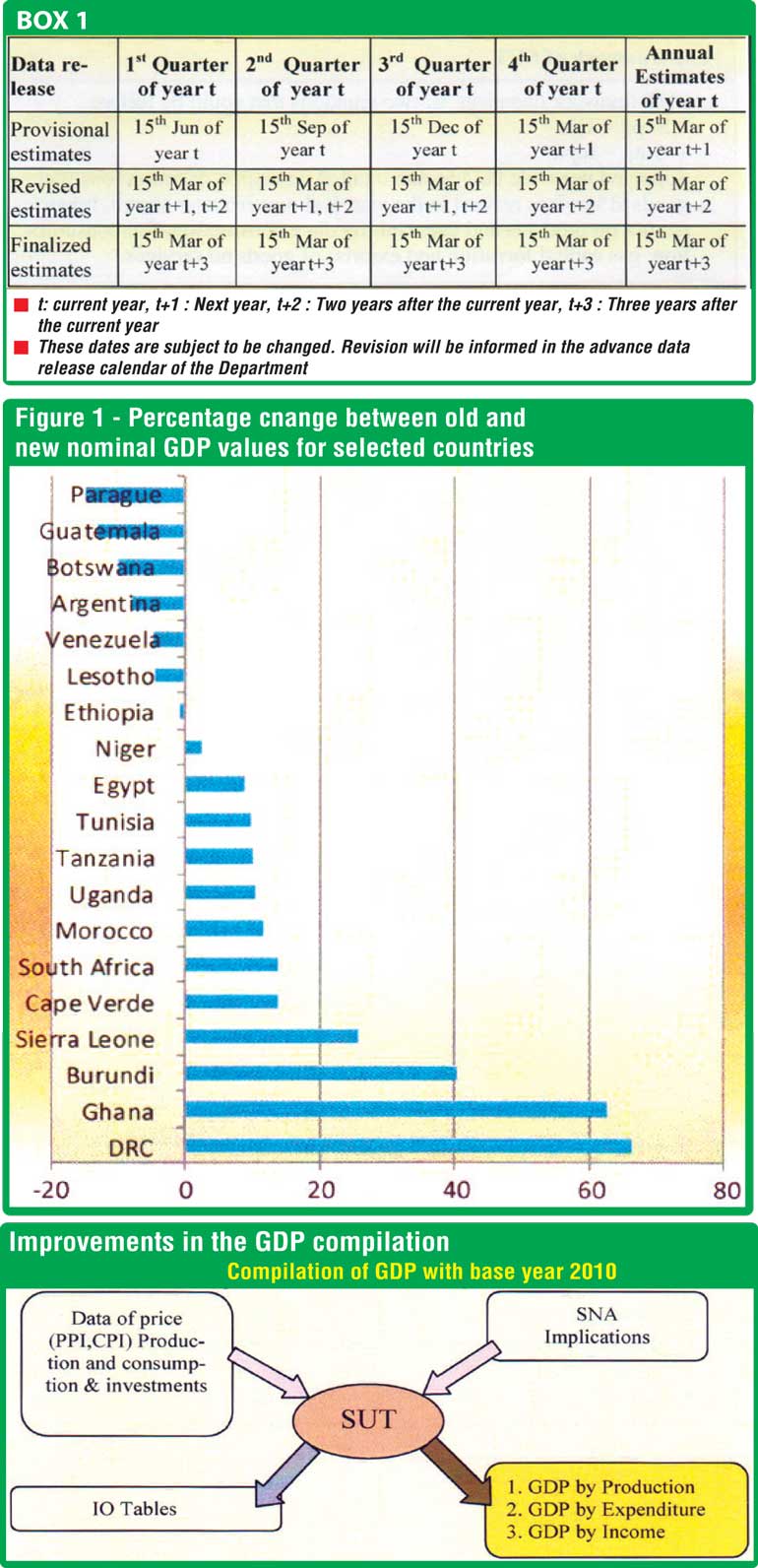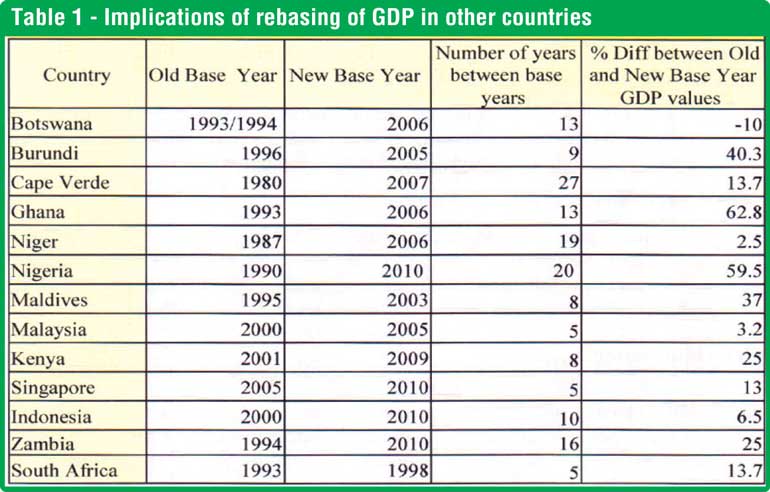Tuesday Mar 18, 2025
Tuesday Mar 18, 2025
Thursday, 16 July 2015 00:00 - - {{hitsCtrl.values.hits}}
By Department of Census and Statistics
Gross Domestic Product (GDP)
GOP can be used to gauge the health of a country’s economy. It can be defined as the monetary value of all finished goods and services produced within an economic territory in a specific period. It is measured in three approaches which are production, expenditure and income that are presented at current and constant prices. GOP is the most important indicator in the System of
National Accounts (SNA).
The System of National Accounts (SNA)
The System of National Accounts (SNA) is the internationally agreed standard set of recommendations on how to compile measures of economic activities. The SNA describes a coherent, consistent and integrated set of macroeconomic accounts in the context of a set of internationally agreed concepts, definitions, classifications and accounting rules.
What is rebasing?
Rebasing of the national account series is the process of replacing an old base year with a new and more recent base year. The base year provides the reference point to which future values of the GDP are compared. The base year was changed from 2002 to 2010 for compilation of national accounts statistics.
Reasons for selecting 2010 as the base year
Reasons for rebasing the GDP
Benefits of rebasing
Improvements introduced with the rebasing
a. Adoption of United Nations System of National Accounts 2008 (SNA-2008)
b. Adoption of classification of sectors
c. Expansion of production boundary
d. Inclusion of economic activities of households
e. Adoption of internationally recommended classifications
a. The System of National Accounts (SNA) 2008
SNA 2008 is the latest version of the International Statistical Standard for the National Accounts, adopted by the United Nations Statistical Commission (UNSC). It is a statistical framework which provides a comprehensive, consistent and flexible set of macroeconomic accounts for policy making, analysis and research.
b. Adoption of Sector Classification
One of the recommendations of the SNA is to compile the national accounts according to the sector classification too. Sector classifications of economic activities are as follows:
c. Expansion of production boundary
Some of the important economic activities were not fully captured in the previous National Accounts Statistics of Sri Lanka. Those are included under the rebasing exercise in a more systematic manner to the maximum extent possible.
Example - Some highly profitable emerging services such as private education, private health services, legal services which were not fully captured in the existing system will be mostly captured under the rebasing exercise.
d. Inclusion of economic activities of households
Under the previous system, production activities of households were not fully captured due to unavailability of household production data. Quarterly Survey of Industries (QSI) and Annual Survey of Industries (ASI) which are main data sources for national accounts compilation, conducted by DCS covered only organised industrial activities. Under the revised methodology more household economic activities are covered to a large extent through a method called Labor Input Method (LIM).
Example - Some professional services such as architectural services, beauty culture services provided by households were not fully captured, but will be covered under this rebasing exercise.
e. Adoption of internationally-recommended classifications
Internationally-accepted standards of classification for economic activities and products, ISIC & CPC respectively, developed by the United Nations, are adopted in the new methods as recommended by the System of National Accounts. As a result, national accounts estimates can be disseminated in broader categories without any duplications or omissions.
Example - Under the existing system, banking, insurance and real estate activities were encompassed as one activity. The rebasing exercise separated the above activities into three activities as given below, facilitating compiling statistics for each level.
The improved GOP estimates are expected to provide a better basis for measuring economic output and growth; informed policy making; and monitoring progress towards the development goals relating especially to poverty alleviation.
In order to increase the quality of GOP, Supply and Use Table (SUT) matrix is also applied.


Supply and Use Tables (SUT)
SUT is an integrated model that allows compilation of more reliable, consistent, and internationally comparable estimates of GOP. SUT describes the balance between flows of production and consumption (goods and services) and income generated from production. The SUT also shows the linkages among industries, sectors and products coherently.
The framework of SUT
SUT framework comprises of two equations that should be fulfilled.
Supply and use table provides the detailed description of transactions with goods and services realised in the year. It shows resources (output, import, net taxes on products) and uses (intermediate consumption, final consumption, gross capital formation and exports) of goods and services.
Advantages of SUT
Revision policy
Numbers of indicators are used in compiling National Accounts Statistics (NAS). However, there are instances where the required data is not available at the time of releasing NAS. Therefore, the NAS released need to be updated when the data is available. This is one of the reasons for having a revision policy. The DCS has introduced a revision policy for NAS with the changing of the base year. Data releasing calendar of NAS which was prepared based on the revision policy for year ‘t’ is given in Box 1.
Experiences of other countries
When revising compilation procedures, various countries have experienced different scenarios with respect to the values of national accounts compiled under the old and new compilation procedures.
Few examples of other countries are given in Table 1.
Table 1 shows old and new GOP values of few countries that have undertaken rebasing exercise recently. Magnitude of the differences between old and new series depends on the improvements made in compiling NAS of those countries.
Figure 1 reveals that some countries had underestimated their GOPs before rebasing exercise, while other countries had overestimated.
Most Important questions of Rebased GDP
In view of the rebased estimates, does it mean that Sri Lanka’s NAS for the previous years have been inaccurate?
The rebased NAS are better reflection of the true size and structure of the economy. It does not mean the old series and its SNA are wrong; it means we are capturing more activities and measuring better.
What comes next after this exercise?
This release is preliminary and a refinement is being undertaken, including a more extensive use of the Supply and Use Table (SUT) framework. DCS plans to release full set of national accounts (GOP by production, income and expenditure approaches) and economic accounts shortly.
To think twice
Discover Kapruka, the leading online shopping platform in Sri Lanka, where you can conveniently send Gifts and Flowers to your loved ones for any event including Valentine ’s Day. Explore a wide range of popular Shopping Categories on Kapruka, including Toys, Groceries, Electronics, Birthday Cakes, Fruits, Chocolates, Flower Bouquets, Clothing, Watches, Lingerie, Gift Sets and Jewellery. Also if you’re interested in selling with Kapruka, Partner Central by Kapruka is the best solution to start with. Moreover, through Kapruka Global Shop, you can also enjoy the convenience of purchasing products from renowned platforms like Amazon and eBay and have them delivered to Sri Lanka.
Discover Kapruka, the leading online shopping platform in Sri Lanka, where you can conveniently send Gifts and Flowers to your loved ones for any event including Valentine ’s Day. Explore a wide range of popular Shopping Categories on Kapruka, including Toys, Groceries, Electronics, Birthday Cakes, Fruits, Chocolates, Flower Bouquets, Clothing, Watches, Lingerie, Gift Sets and Jewellery. Also if you’re interested in selling with Kapruka, Partner Central by Kapruka is the best solution to start with. Moreover, through Kapruka Global Shop, you can also enjoy the convenience of purchasing products from renowned platforms like Amazon and eBay and have them delivered to Sri Lanka.